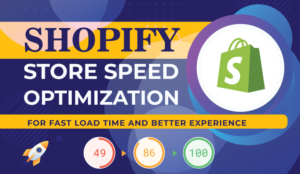Optimizing and Boosting Your Shopify Store
Optimizing and Boosting Your Shopify Store to maximize its potential and drive increased sales. In the competitive world of e-commerce, the success of your Shopify store depends significantly on its performance. Slow-loading pages and a clunky user experience can drive potential customers away. To ensure optimal performance, follow these key strategies:

- Optimize Images: Compress and resize images to reduce page load times. Use tools like Tiny PNG or Image Optimize to maintain quality while minimizing file sizes.
- Minimize Apps: Review and uninstall unnecessary apps. Each app adds code to your store, potentially slowing it down. Keep only essential apps that add real value to the user experience.
- Choose a Responsive Theme: Opt. for a mobile-responsive theme to ensure a seamless experience across devices. Google prioritizes mobile-friendly sites, impacting your SEO ranking.
- Enable Browser Caching: Leverage browser caching to store static files, allowing returning visitors to load your site faster. Shopify has built-in caching, but you can further enhance it using third-party apps.
- Reduce HTTP Requests: Minimize the number of elements on each page to decrease HTTP requests. Combine CSS and JavaScript files to streamline loading.
- Content Delivery Network (CDN): Implement a CDN to distribute your content across multiple servers globally. This reduces latency, ensuring faster page loads for users worldwide.
- Lazy Loading: Employ lazy loading for images, meaning they load only as users scroll down the page. This reduces the initial load time, improving the overall user experience.
- Optimize Code: Regularly audit and clean up your code. Remove unnecessary spaces, comments, and code that isn’t contributing to your site’s functionality.
- Upgrade Hosting Plan: Ensure your hosting plan meets your store’s needs. If experiencing high traffic, consider upgrading to a plan with more bandwidth and resources.
- Monitor Performance: Regularly check your store’s performance using tools like Google Page Speed Insights. Address any issues identified to maintain optimal speed.
